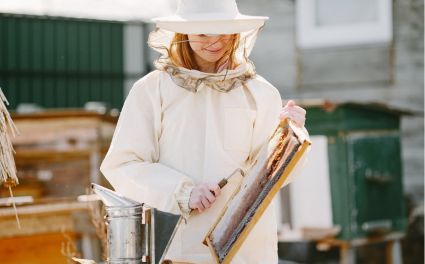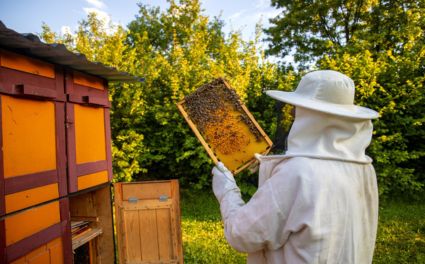Bees are known for their endless energy and hard work — but do these tireless pollinators ever take a break? Surprisingly, yes. Researchers have discovered that honey bees experience sleep-like states, much like other living creatures. These moments of rest are essential for their survival, memory, and overall hive productivity.
In this guide, we’ll uncover how bees rest, why it’s crucial for colony health, and what it tells us about the complex world inside the hive.
🌼 Understanding Bee Behavior
Bees are some of nature’s most organized workers. Throughout the day, they collect nectar, care for brood, clean the hive, and protect their queen. As the sun sets, activity slows — the hive becomes quieter, and bees prepare for rest.
Worker bees that have spent the day foraging return home, grooming themselves and joining the cluster inside the hive. This downtime helps them conserve energy and recover from long flights. Even the queen bee, constantly busy laying eggs, reduces her activity as night approaches.
During these low-activity periods, bees move less and form tight clusters to maintain warmth — a behavior vital for the colony’s health, especially during cooler nights.
For beekeepers observing nocturnal hive behavior, protective clothing like beekeeping jackets or lightweight suits ensures comfort and sting protection during inspections or maintenance at dusk.

🌙 Changes in Bee Behavior During Rest
When bees “sleep,” their behavior visibly changes. They may remain motionless inside comb cells or adopt a relaxed, head-down position. These sleep-like states differ from day-to-day work; bees exhibit slower reactions and reduced responsiveness to outside stimuli.
Groups of worker bees often rest together in the hive — a strategy that helps them conserve warmth and maintain colony stability. Others, particularly younger bees, may rest on the edges of comb cells or near brood chambers.
These natural rest cycles play a crucial role in hive dynamics. Without them, the efficiency of honey bees would decline, affecting tasks such as foraging, pollination, and communication within the colony.
Also read: Bee Nest vs Wasp Nest
🌙 Nocturnal Adaptations and Hive Maintenance
Even while most bees rest, the hive never fully sleeps. Some worker bees continue essential maintenance tasks such as:
-
Repairing comb structures
-
Fanning their wings to regulate hive temperature
-
Guarding the hive entrance against predators
These night duties ensure the colony remains safe and stable. Guard bees, for instance, stand alert throughout the night, protecting the hive from wasps and other intruders.
During such evening inspections or repairs, beekeepers benefit from breathable beekeeping suits that offer flexibility and safety in low-light conditions.
💤 Bee Sleep Patterns
Scientific studies using electroencephalogram (EEG) have shown that bees experience measurable changes in brain activity during rest. Their sensory response and neural signaling slow down, similar to how mammals experience reduced awareness during sleep.
Unlike humans, bees don’t have REM (rapid eye movement) sleep, but they do exhibit periodic “sleep phases” that help them recover. These cycles are essential for maintaining focus, orientation, and learning capacity — all crucial for daily foraging.
When worker bees rest, enzyme activity and neural functions adjust to help the bee restore energy. Without adequate rest, bees struggle with tasks like navigation and dance communication — proof that even these tiny creatures rely on rest to perform efficiently.
🌡️ Environmental Factors Affecting Bee Rest
Bee sleep patterns are influenced by temperature, light, and hive conditions. Warm, stable temperatures encourage consistent resting cycles, while cold or poorly ventilated hives disrupt their sleep-like behavior.
Light plays a key role too. Bees rely on the sun for navigation, so when daylight fades, it signals the hive to transition into a resting state. Maintaining optimal hive insulation, airflow, and humidity is vital — not only for rest but also for the overall health of the colony.
Beekeepers can manage these environmental conditions using proper beekeeping equipments such as ventilated lids, hive wraps, and thermometers to keep the hive balanced through seasonal changes.
🧠 The Science Behind Bee Sleep
Recent studies show that when bees rest, specific parts of their brains become less active. This indicates that bee sleep supports memory consolidation and learning — helping them remember which flowers offer the best nectar or how to navigate back to the hive.
Just like humans, sleep-deprived bees exhibit reduced coordination and slower reactions. Their communication dances become less accurate, affecting how well other bees can find food.
The balance between rest and activity is part of what makes honey bees such efficient pollinators — proof that even the hardest workers in nature need recovery time.
🐜 Comparing Bee Sleep to Other Insects
When compared to other insects, bees show unique sleep behaviors. For instance, unlike ants or beetles that rest irregularly, honey bees have more structured rest cycles that align with day-night rhythms.
However, their sleep lacks the deep or REM-like stages observed in birds and mammals. Despite this, studies reveal fascinating similarities in memory processing — bees seem to “learn while they rest,” strengthening neural connections just like humans do.
Researchers suggest that this sleep-memory link might explain bees’ remarkable ability to recall floral patterns and communicate directions using the “waggle dance.”
Also read: Bumblebee vs Honeybee
🛌 Why Sleep Is Essential for Bee Health
Sleep is vital for every bee in the hive. It restores energy, regulates metabolism, and supports the complex cognitive functions needed for navigation, memory, and communication.
Without proper rest, bees can become disoriented, lose efficiency in foraging, and even experience immune weakness. Over time, this can impact honey production and colony stability.
Healthy colonies rely on both balanced nutrition and adequate rest — two factors that beekeepers can support by maintaining well-ventilated, protected hives and minimizing nighttime disturbances.
Beekeepers often use beekeeping gloves and beekeeping veils for added safety during maintenance tasks, ensuring comfort and control when managing colonies.
⚠️ The Effects of Sleep Deprivation on Bees
Just like humans, sleep-deprived bees struggle with performance. They may forget foraging routes or perform disoriented waggle dances, causing communication breakdowns within the colony.
Prolonged lack of rest can increase stress hormones and weaken bees’ immune responses, making them more vulnerable to disease and parasites. These issues can cascade, reducing hive productivity and endangering the colony’s survival.
This emphasizes how delicate the balance of nature is — even small disruptions in bee rest patterns can impact pollination cycles and ecosystems worldwide.

🧵 The Beekeeper’s Role in Supporting Healthy Colonies
A responsible beekeeper ensures bees have the ideal environment to rest and recover. This includes using proper insulation, maintaining airflow, and preventing unnecessary nighttime interference.
High-quality protective gear — such as beekeeping trousers, beekeeping kids suits, and beekeeping ankle protection — makes hive management easier while reducing sting risks for keepers of all ages.
Brands like OZ Armour are widely respected among professional and hobbyist beekeepers for crafting durable and ventilated suits — including elegant pink bee suits — designed for comfort and reliability.
Also read: Do Bee Suits Protect from Wasps?
🌸 Final Thoughts
In conclusion, bees do sleep — or at least experience sleep-like states that are critical to their health and the overall balance of the hive. These resting phases recharge their bodies, improve learning and communication, and ensure colony survival.
By understanding and respecting bee sleep patterns, beekeepers and researchers alike can promote healthier colonies and more sustainable ecosystems.
To explore more fascinating insights about the lives of bees, visit The Secret Lives of Bees or Read More Blogs About Beekeeping to expand your knowledge of these incredible creatures that sustain our world.



